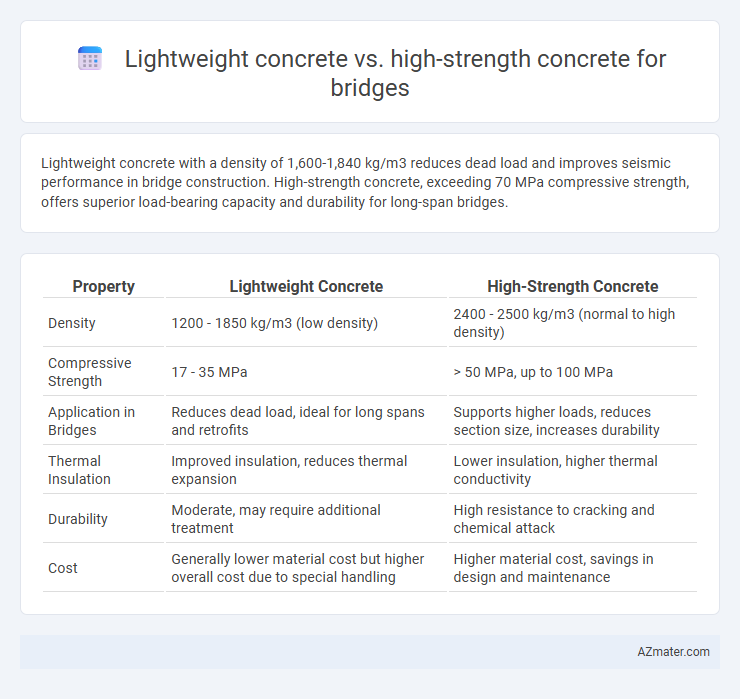Lightweight concrete with a density of 1,600-1,840 kg/m3 reduces dead load and improves seismic performance in bridge construction. High-strength concrete, exceeding 70 MPa compressive strength, offers superior load-bearing capacity and durability for long-span bridges.
Table of Comparison
| Property | Lightweight Concrete | High-Strength Concrete |
|---|---|---|
| Density | 1200 - 1850 kg/m3 (low density) | 2400 - 2500 kg/m3 (normal to high density) |
| Compressive Strength | 17 - 35 MPa | > 50 MPa, up to 100 MPa |
| Application in Bridges | Reduces dead load, ideal for long spans and retrofits | Supports higher loads, reduces section size, increases durability |
| Thermal Insulation | Improved insulation, reduces thermal expansion | Lower insulation, higher thermal conductivity |
| Durability | Moderate, may require additional treatment | High resistance to cracking and chemical attack |
| Cost | Generally lower material cost but higher overall cost due to special handling | Higher material cost, savings in design and maintenance |
Introduction to Lightweight and High-Strength Concrete
Lightweight concrete, characterized by densities ranging from 1,440 to 1,840 kg/m3, offers reduced structural loads and improved thermal insulation ideal for bridge decks and girders. High-strength concrete, with compressive strengths exceeding 70 MPa, provides enhanced durability and load-bearing capacity, crucial for long-span bridges and heavily trafficked infrastructures. Both materials optimize bridge performance but differ significantly in density, strength, and application based on design requirements.
Key Properties and Composition
Lightweight concrete features reduced density achieved by incorporating lightweight aggregates such as expanded clay or shale, offering enhanced thermal insulation and decreased dead load, making it ideal for long-span bridge decks. High-strength concrete is characterized by its compressive strength exceeding 6,000 psi, attained through a carefully controlled mix with low water-to-cement ratio, silica fume, and superplasticizers, providing superior durability and load-bearing capacity in bridge piers and foundations. Both types optimize structural performance: lightweight concrete minimizes weight without compromising durability, while high-strength concrete ensures robust resistance to heavy loads and harsh environmental conditions.
Weight Comparison and Structural Implications
Lightweight concrete typically has a density ranging from 1,440 to 1,840 kg/m3, significantly lower than high-strength concrete's density of about 2,400 kg/m3, offering substantial reduction in dead load for bridge structures. This weight reduction in lightweight concrete enhances seismic performance and reduces foundation requirements, leading to cost savings in substructure design. High-strength concrete provides superior compressive strength above 70 MPa, enabling longer spans and thinner sections, but the increased weight demands robust support systems and can elevate seismic forces on the bridge.
Compressive Strength Differences
Lightweight concrete typically has a compressive strength ranging from 17 to 70 MPa, offering reduced dead load for bridges compared to traditional materials. High-strength concrete exhibits compressive strengths exceeding 70 MPa, often reaching up to 140 MPa, providing superior load-bearing capacity for bridge structures. The choice between lightweight and high-strength concrete depends on balancing structural requirements with weight considerations and durability.
Durability and Longevity in Bridge Applications
Lightweight concrete offers enhanced durability in bridge applications by reducing dead load, which minimizes stress and potential cracking over time, leading to extended structural longevity. High-strength concrete provides superior compressive strength, making it ideal for load-bearing components, yet it may be more susceptible to shrinkage and thermal cracking if not properly cured. Selecting between lightweight and high-strength concrete depends on balancing durability factors such as resistance to freeze-thaw cycles and chloride ingress versus mechanical performance under dynamic traffic loads.
Construction Techniques and Workability
Lightweight concrete offers superior workability and reduced dead load, enabling easier handling and accelerated placement in bridge construction. High-strength concrete demands precise mixing and curing techniques to achieve its enhanced compressive strength, often requiring specialized equipment and skilled labor for proper consolidation. The choice between the two depends on project-specific factors such as load requirements and construction timeline, with lightweight concrete facilitating faster construction and high-strength concrete providing increased structural capacity.
Cost Analysis and Material Efficiency
Lightweight concrete reduces overall bridge dead load, lowering foundation and structural steel costs, while high-strength concrete provides superior compressive strength enabling slimmer, more efficient designs that minimize material volume. Cost analysis reveals lightweight concrete often leads to savings in transportation and handling due to its reduced density, contrasting with the higher upfront material costs but longer service life and lower maintenance expenses of high-strength concrete. Material efficiency in bridges favors high-strength concrete for critical load-bearing elements, whereas lightweight concrete excels in non-structural or secondary components, optimizing total project expenditure and performance.
Environmental Impact and Sustainability
Lightweight concrete reduces the overall structural load, leading to lower material consumption and decreased carbon emissions during transportation and construction, enhancing environmental sustainability. High-strength concrete, while offering superior load-bearing capacity and durability, typically involves higher cement content, contributing to greater CO2 emissions and environmental impact. Choosing lightweight concrete in bridge construction supports sustainable practices by minimizing energy use and promoting resource efficiency without compromising structural integrity.
Case Studies of Bridge Projects
Case studies of bridge projects reveal that lightweight concrete reduces dead load by up to 35%, enabling longer spans and cost savings in support structures, as demonstrated in the Lake Pontchartrain Causeway extension. High-strength concrete, with compressive strengths exceeding 70 MPa, is preferred in urban bridges like the Millau Viaduct for its superior load-bearing capacity and durability under heavy traffic conditions. Comparative analyses indicate that lightweight concrete enhances seismic resilience and faster construction times, whereas high-strength concrete excels in load performance and longevity.
Choosing the Right Concrete for Bridge Construction
Lightweight concrete offers benefits in bridge construction due to its reduced dead load, enhancing structural efficiency and lowering foundation costs, especially for long-span bridges. High-strength concrete provides superior compressive strength essential for supporting heavy loads and resisting harsh environmental conditions, making it ideal for critical load-bearing elements. Selecting the appropriate concrete depends on project requirements such as load capacity, durability, and cost, ensuring optimal performance and longevity of the bridge structure.

Infographic: Lightweight concrete vs High-strength concrete for Bridge
 azmater.com
azmater.com